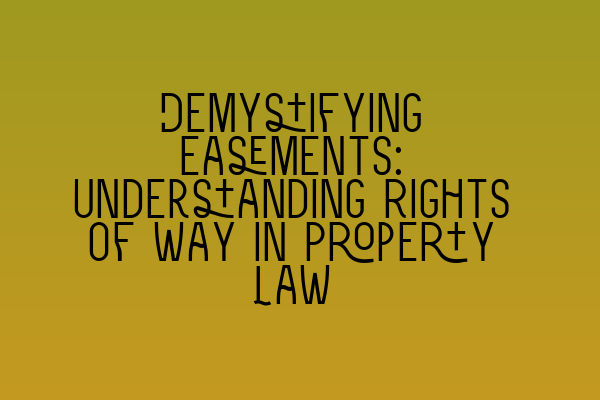Demystifying Easements: Understanding Rights of Way in Property Law
When it comes to property law, understanding easements and rights of way can often feel like a complex and confusing maze. However, demystifying these concepts is crucial for property owners, developers, and anyone involved in buying or selling property. In this blog post, we will break down the topic of easements and shed light on the key aspects of rights of way in property law. Whether you are a solicitor, a law student preparing for the SQE exams, or simply an individual looking to understand your property rights, this guide will provide you with valuable insights.
What is an Easement?
An easement, in simple terms, is a legal right that allows a person to use another person’s land for a specific purpose. This right can be granted as part of a property sale, or it may have been granted in the past and is now legally binding on the current owner. Easements exist to ensure that certain necessary rights are preserved, even if the ownership of the property changes.
In the context of property law, the most common type of easement is a right of way. A right of way allows one person the right to travel across another person’s property to access their own property or a public road. This can be in the form of a footpath, driveway, or even a complete roadway. Understanding the intricacies of rights of way is essential, especially when disputes arise, and legal advice is required.
Creation and Types of Easements
Easements can be created in several ways, the most common being:
- Express Grant: When the owner of the property specifically grants an easement to another party. This can be done through a written agreement or deed.
- Implied Grant: When circumstances imply the existence of an easement. For example, if two adjoining properties were previously one property and later divided into separate lots, an implied easement might exist for the benefit of one property to access a public road through the other property.
- Prior Use: When an existing use of an area of land becomes an easement after the land is divided and sold. This is common when a property has been using a specific access route for many years, even though it may not have been documented or agreed upon explicitly.
- Necessity: When an easement is necessary to access or use a property. This is typically the case when a landlocked property needs a right of way over a neighboring property to reach a public road.
It’s important to note that easements can be either appurtenant or in gross. An appurtenant easement benefits a particular property, meaning that the right of way runs with the land and is transferred to subsequent property owners. An easement in gross, on the other hand, benefits a specific individual or entity, regardless of the property they own. Understanding the classification of an easement is crucial in determining its transferability and enforcement.
Enforcement and Disputes
While many easements are straightforward and amicably used by all parties involved, disputes can arise. Common issues include restrictions on the use of the right of way, maintenance responsibilities, or disagreement over the existence or validity of an easement. Resolving these disputes often requires legal intervention, and seeking advice from a solicitor well-versed in property law is highly recommended.
When a dispute arises, the concerned parties may need to apply to the court to seek clarification or resolution. The court will consider various factors, such as the terms of the easement, the intentions of the parties involved, and any surrounding circumstances. It’s worth noting that the court’s primary objective is to ensure the reasonable use and enjoyment of the dominant property while weighing the rights and interests of all parties involved.
SQE Preparation and Resources
If you’re a law student preparing for the Solicitors Qualifying Exam (SQE) or a professional looking to expand your knowledge in property law, we have a range of resources and courses to assist you. Our SQE 1 and SQE 2 preparation courses are designed to equip you with the knowledge and skills required to pass the exams with confidence. Additionally, for SQE 1 practice, we offer MCQ practice exam questions and practice mocks (FLK1 and FLK2) to help you familiarize yourself with the exam format.
For a complete overview of our SQE preparation courses, exam dates, and more, please visit our website: SQE 1 Preparation Courses and SQE 2 Preparation Courses or check out the SRA SQE Exam Dates.
Conclusion
Easements and rights of way are vital components of property law, ensuring the smooth functioning and efficient use of land. Understanding the creation, types, enforcement, and potential disputes surrounding easements is crucial for property owners, developers, and legal professionals. By gaining a clear understanding of these concepts, you can navigate through property transactions and resolve any issues that arise with confidence.
If you require legal advice or further assistance regarding easements or any other aspect of property law, we highly recommend consulting with an experienced solicitor who specializes in property law. Their expertise will ensure that your rights are protected, and any potential disputes are resolved in the most efficient and satisfactory manner.
